The notion that comics could be collectible and worthy of critical study emerged in North America, somewhat organically, during the mid-to-late 1960s. The advent of comic book shops, comic conventions and comic fanzines all came to fruition during this decade. That said, fanzines and conventions were not exactly novel ideas and instead borrowed from already established formats from the world of science fiction fandom. This month, I will trace how the emergence of comic book fandom in Canada during the 1960s was influenced by science fiction fandom in the decades that preceded it and how one man, “Captain” George Henderson, played a pivotal role in bringing this to fruition. This is the first entry of a multipart examination of Canadian comic conventions and fanzines. Let’s get started.
The world’s first major science fiction convention, Worldcon, occurred in New York City in 1939 and was called “Nycon.” The sixth Worldcon, “Torcon,” took place in Toronto in 1948. As such, Canada was already participating in the emergence of fandom during an era when comic books were still a fledgling art form that was dismissed as being for children (while simultaneously being blamed for juvenile delinquency). By the time Worldcon returned to Toronto for “Torcon II” in 1973, comic book fandom was in full swing.
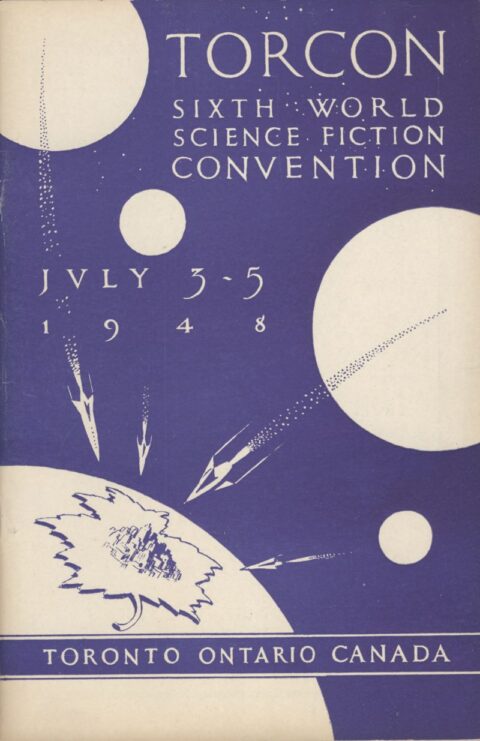
The science fiction fanzine, understandably, predates the emergence of conventions by almost a decade. The first such fanzine, The Comet, was released in 1930 by the Science Correspondence Club in Chicago. By the 1940s, many such fanzines were being distributed by amateur press associations (APAs) across the continent. APAs functioned as follows: A fan would join an APA and would send their fanzine to the association, which would then print and circulate their fanzine to other members. The success of these early fanzines and APAs led to the format eventually being adopted by fans of music, cinema and comics in the decades that followed. By 1955, science fiction fanzines were so important for the genre’s fandom that Worldcon began awarding a Hugo Award for Best Fanzine. By the time comic books became a worthy domain of fandom, science fiction fandom through fanzines and conventions was already an accepted (albeit niche) part of popular culture.
The rumoured first Canadian science fiction fanzine, The Canadian Science Fiction Fan, was published in 1936. The editor/creator remains unknown and there are no known extant copies. The only reason why this fanzine is said to have ever existed is that it was reviewed by Don Wollheim the year it was published. Wollheim was a fixture of early science fiction fandom in North America during the 1930s, helping to establish the Fantasy Amateur Press Association (FAPA) in 1937. FAPA was the world’s first fan APA and is still in existence today. Wollheim was also one of the founders of the Futurian Society in New York City in 1938, which was an early (and influential) science fiction fan club. Early members of the group included Isaac Asimov and Frederic Pohl who would go on to have distinguished writing careers. Despite there being no extant copies of The Canadian Science Fiction Fan, Wollheim’s review supports the idea that it was the first Canadian fanzine.
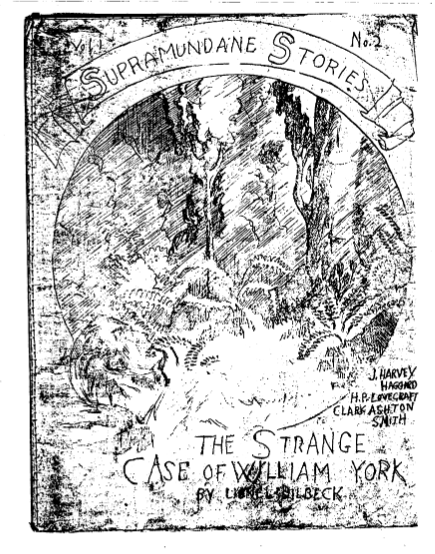
The earliest surviving Canadian science fiction fanzine, SupraMundane Stories, was printed in British Columbia and appeared in either late 1936 or early 1937. A second and final issue was circulated in 1938. Both were released by Nils Helmer Frome, who used a multigraph machine to produce copies of his fanzine. Both of the covers were drawn by Frome, who was a teenager at the time. The first issue featured fiction by Lionel Dilbeck and poetry by J. Harvey Haggard, with additional writing by Frome. The second issue featured a story by H.P. Lovecraft called “Nyarlathotep,” as well as a poem by Clark Ashton Smith. Frome had been corresponding with Lovecraft at the time, who encouraged Frome to publish the zine and also suggested including the poem by Ashton Smith. Thanks to the Canadian SF Fanzine Archive, both issues of this rare, early example of Canadian science fiction fandom are available in PDF form.
The most successful of early Canadian fanzines, however, was Light, which morphed out of the Croutch Magazine Mart News (CMMN) and eventually became Canada’s third science fiction fanzine. CMMN debuted in 1937 or 1938 and was published by Leslie Croutch of Parry Sound, Ontario. Originally, the fanzine was what would eventually be referred to as an “adzine,” as it listed Croutch’s stock for trading with other enthusiasts. Apparently, he would carbon copy a handful of these lists and mail them to friends or potential trade partners. Croutch did not keep copies for his own records until CMMN # 86, which he circulated in 1940. Today, there are no known surviving copies of CMMN.
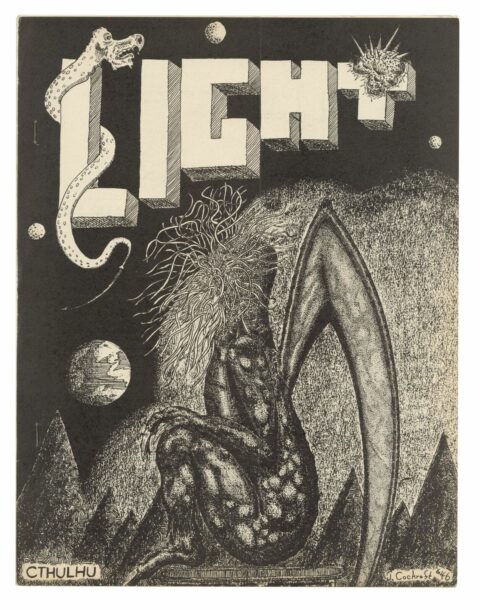
In 1941, after his adzine had undergone a couple of name changes, he released the first issue of Light, a mimeographed general-interest science fiction fanzine. He also joined FAPA in 1943 with issue # 129, becoming one of the first Canadian fanzines distributed by the famed APA. Initially, Light would continue the numbering from CMMN, beginning with issue # 108 and this numbering would continue until issue # 135, which was circulated towards the end of 1945. Afterwards, Croutch restructured the numbering system and the November 1945 issue of Light became issue # 29. Croutch continued the series with this new numbering system until it ended with issue # 69 in 1961. These fanzines are incredibly rare today having only had print runs of between 50 and 100 copies, but many issues of Light are available online thanks to the efforts of the Fanac Fan History Project.
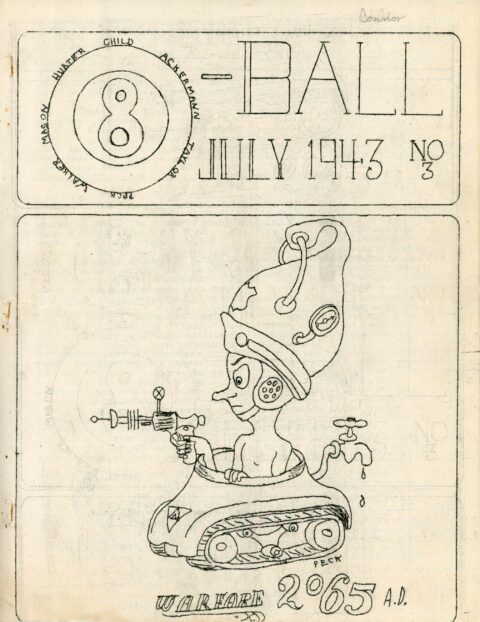
Another important Canadian science fiction fanzine, aptly titled Canadian Fandom, debuted in 1943 and was originally edited by Beak Taylor. The fanzine was a reworked version of Taylor’s previous fanzine, which was called 8-Ball or Eightball. Canadian Fandom was one of the original members of Canada’s first APA, the Canadian Amateur Fan Publishers (CAFP), which was sometimes referred to as the Canadian Amateur Fantasy Publishers. This APA was started by Fred Hurter Jr. in 1942, who was also a member of FAPA. The first three zines that were part of CAFP were Hurter’s Censored (which ran for six issues), Croutch’s Light, and Canadian Fandom which went through several editors after Taylor and ran for at least thirty-one issues until 1956.
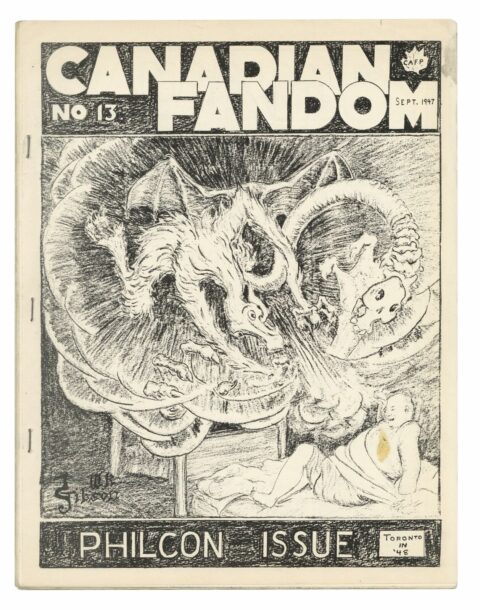
Like Light, Taylor’s Canadian Fandom became a significant promoter of science fiction fandom in Canada. Interestingly, Frome often contributed artwork (including several covers) to the fanzine. All of these fanzine editors and the zines themselves played a role in the promotion of Torcon. Unfortunately, the CAFP never properly functioned as an APA and by the early 1950s, it was effectively defunct.
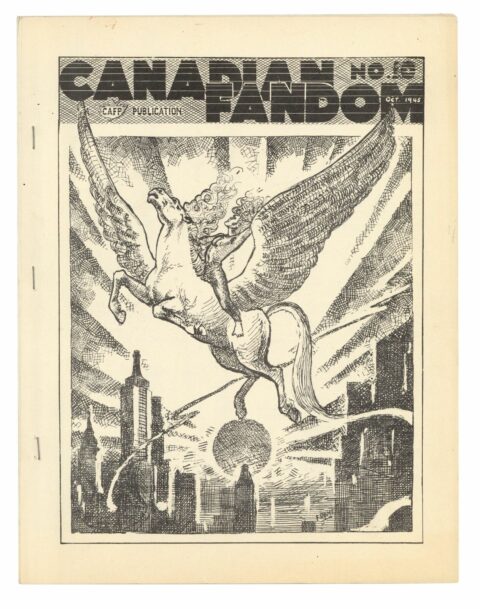
These early Canadian science fiction fanzines were part of a larger movement across North America at the time. Thanks to organizations like FAPA, science fiction fandom was able to slowly spread across the continent, as nascent fan clubs and fledgling groups of amateur writers, creators and enthusiasts found solidarity in their shared hobby. Events like Worldcon and the circulation of numerous fanzines became templates for what would happen in the 1960s. Recognizing these early Canadian fanzines, as well as the first Torcon event, helps to situate the emergence of other kinds of fandom (especially comic and film fandom) during the 1960s as being a logical extension of these earlier movements.
In Canada, the emergence of comic book fanzines and conventions can be traced to the efforts of “Captain” George Henderson. Certainly, as long as there have been comic books, people have been collecting them. Yet, Henderson was the person who brought the idea of the local comic shop into the Canadian mainstream when he opened what would morph into Canada’s first comic store, the Viking Bookshop, in 1966. As part of this trajectory, Henderson would also become the first major Canadian publisher of comic fanzines (which I will return to next month).
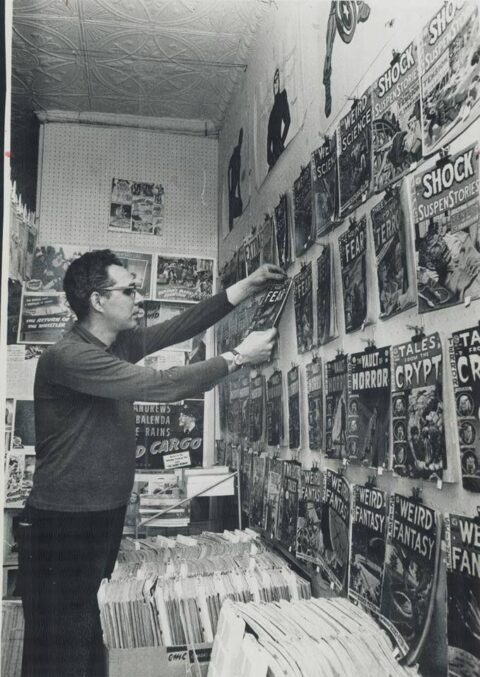
Henderson played a significant role in bringing comic conventions to Canada too. On November 27, 1966, he organized something of a (prototype) comic convention, Com-Ex, which took place at the University of Toronto’s Hart House on November 27 and featured several of Henderson’s most valuable comics on display as part of an exhibit. Com-Ex was presented by the “Canadian Academy of Comic Book Collectors and the Hart House Library Committee.” It was intended to be an exposition where collectors and enthusiasts would display their prized comics and/or artwork and compare collections. Film critic Michael Walsh was a student at the University of Toronto at the time and was also a member of the Hart House Committee that helped present the event. He also covered the story for the university’s student newspaper (The Varsity). I recommend taking a look at Walsh’s explanation of how the event came together on his “Reeling Back” blog.
Henderson was born in Montreal in 1930. As a child, he bounced between various foster homes, finding solace in comic books and cinema, while also writing poetry. As a young man, he joined the Canadian military, becoming a parachutist. He was discharged from the military after serving for twelve years. Afterwards, he wrote soft-core pornographic novels for a time before opening the aforementioned Viking Bookshop on Queen Street West in early 1966. The store was the first in Canada to specialize in comic books. He moved his shop to Markham Street in 1967, renaming it Memory Lane.
Around this time, Henderson helped found the Ontario Science Fiction Club (OSFiC), which he hosted at his store. Founding members also included Mike Glicksohn and Peter Gill. Early members of the group included several people who would become important participants in the emergence of Canadian fandom such as Hugo Award-winning artist Alicia Austin, Operation Missile creator Derek Carter, and editor John Douglas. Another key member of the OSFiC was John Millard, who had been part of various science fiction fan groups in the United States during the early 1940s before he moved to Toronto after WWII. Millard had been part of the group that organized Torcon in 1948 and chaired Torcon II in 1973 (which was sponsored by the OSFiC).
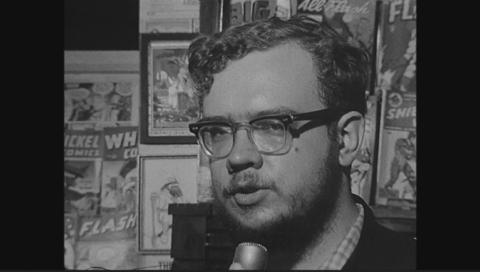
Prior to Torcon II, Henderson helped to present the first fan convention in Canada that included comic books, 1968’s Toronto Triple Fan Fair (also referred to as Fan Fair I), which also catered to fans of science fiction and genre cinema. The convention likely took its name from a similarly named Detroit-based convention that occurred around the same. The event was sponsored by the OSFiC, Memory Lane, the Canadian Academy of Comic Book Collectors, and the Markham Village Film Club. It took place from June 29-July 1, 1968 outdoors in tents on Markham Street. The guests of honour were Roger Zelazny and Stan Lee. Noted Canadian poet and writer Phyllis Gotlieb was also in attendance. The highlight of the program featured a debate about Stanley Kubrick’s film 2001: A Space Odyssey that featured Zelazny, Lee and Gotlieb and was moderated by OSFiC member Ken Smookler. In less than two years, Henderson had gone from organizing Com-Ex at Hart House to operating Canada’s first comic book shop and presenting the country’s first comic book convention.
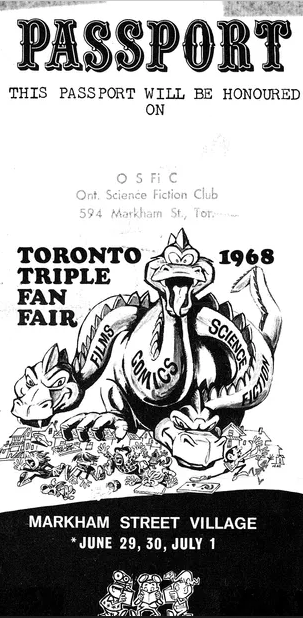
A second Fan Fair (featuring Isaac Asimov and Anne McCaffrey) would take place in 1970 and a final convention, Fan Fair III, would occur in 1975. That said, these were still small-scale events that only hosted several hundred attendees, rather than the (tens of) thousands who attend similar events today. 1973’s Torcon II was difficult and took its toll on members of the OSFiC. Meanwhile, 1975’s Fan Fair III was poorly received by attendees and a fourth convention was abandoned. The club published various science fiction fanzines throughout the rest of the 1970s and into the early 1980s such as Ishue, Distaff, Chronic and Synapse. However, the OSFiC disbanded in 1984.
From what I understand, Henderson’s involvement in presenting conventions dwindled after the Fan Fair I and he instead became focused on creating something of a mini publishing empire, operating his comic shop and expanding to his own gallery. I will return to this next month, while also highlighting the importance of the next big convention to hit the Canadian scene, Cosmicon, and the emergence of a plethora of new comic fanzines. The people who put on these events and circulated these publications kept comic books alive during this era and their stories are worthy of critical discussion. I am excited to have an opportunity to cover this material here and hope you will join me for next month’s instalment.

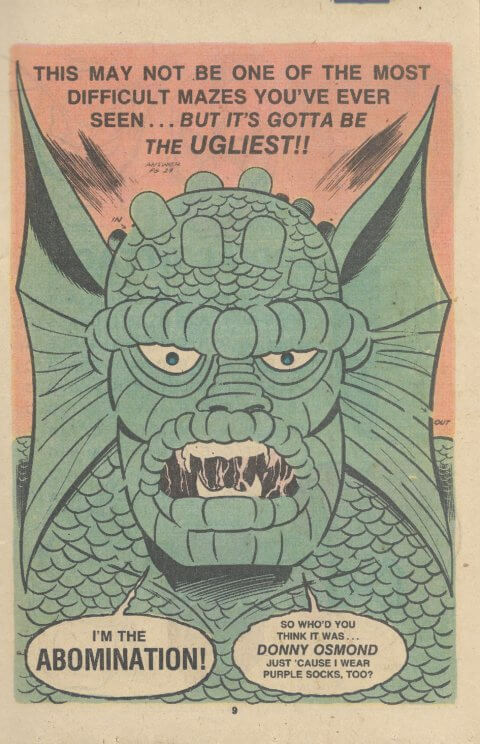
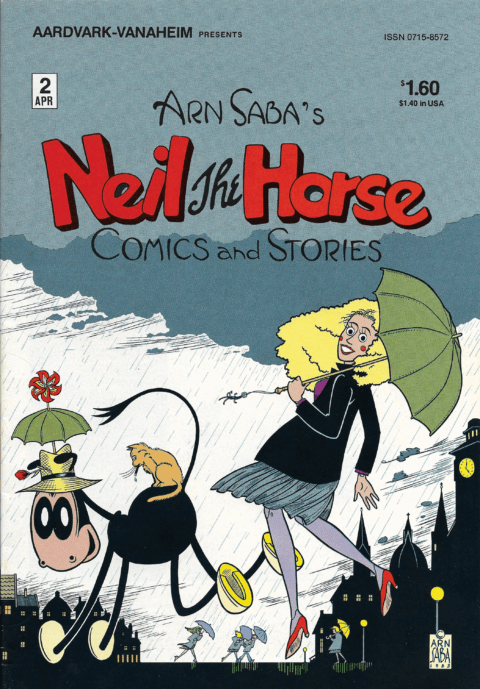
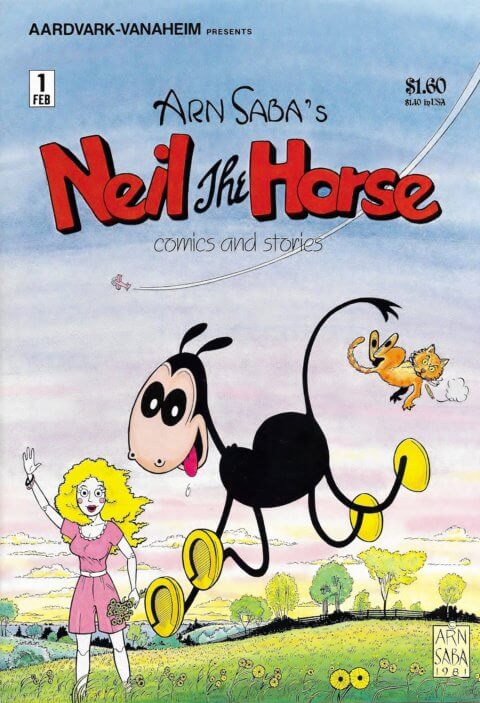
Great post brian, and I’m really looking forward to part two. Memory Lane was the first comic specialty shop I ever stepped into, and, believe me, it was mind blowing at the time. I had never seen so many old comics all in one place before. I remember I was thrilled to find Fantastic Four 48-51 in great condition for about three or four bucks each. This was only a couple of years after these books came out and it was a big deal for me at the time to spend several dollars on a book that originally sold for twelve cents! Sadly, I had not yet discovered the great Canadian Golden Age books, so passed by that box of dollar comics that nobody seemed to want! Captain George was a bit of a surly bugger when he wanted to be, and was not averse to refusing to sell a book to anyone he didn’t like. A real character in his own right. I remember the story of when he put a copy of Batman #1 in his window with a then-unheard-of price of $500, and the cops arrived to check it out, assuming that any paper product for sale at such an exorbitant price must be blotter acid! University curtailed much of my collecting and it wasn’t until years later that I walked into Harry Kremer’s Now and Then Books in Kitchener and got hooked all over again! It was at Harry’s (I rarely heard anyone call Harry’s “Now and Then”) that I got the thrill of seeing my own work on the shelves for the first time. But Memory Lane will always hold a special place in my heart.
Check out yhis url for video related to this story. https://www.cbc.ca/archives/when-collecting-old-comic-books-was-a-new-idea-1.5129732
Brian:
This is really important archival work.
I am old enough to have lived some of this and appreciate the depth of your research on our comic history.
It is important to get this written down correctly, where someone might make corrections, and I thank you for this hard work.
It does remind me that those of us who are ‘independent scholars’ have done much of the heavy lifting on research on various avenues of popular culture.
After 60 years of paying attention of these seemingly simple popular things and exhibited some of them It is good to see serious documentation of our everyday history.
I await the next chapter.
M.
Okay. let’s try this url for the video: https://www.youtube.com/watch?v=vJMDm1eUoEE
We featured this in 2011: https://www.comicbookdaily.com/championing_comics/progressive-shops/canadas-first-comic-shop/
Thanks for your comments, everyone.
mel, I really appreciate you sharing your experiences interacting with “Captain” George at Memory Lane back in the day. There is something magical about going to one’s local comic shop and experiencing that mind blowing feeling for the first time. My experiences visiting comic shops as a child in the late 1980s and early 1990s were few and far between because of growing up in rural Nova Scotia. Halifax was an hour and a half away and convincing my parents to take me to Odyssey 2000 back then was not going to happen. They would humour me sometimes when we would go to the Annapolis Valley’s commercial centre, New Minas, which had the region’s only comic shop. I remember the awe I felt going to Valley Hobby & Comic Stop back then and pining over the copy of X-Men # 16 that they had in their showcase for $100. At the time, it was the oldest comic book I had ever seen and the X-Men cartoon was all the rage on Saturday mornings. There was no way I was ever going to save enough lunch money for that comic, but I eventually was able to purchase one as an adult and have since owned it several times. The shop closed during the late 1990s to little fanfare, but I have always felt nostalgic about that place. Henderson paved the way by helping to legitimize the hobby in Canada.
Wayne, thanks for your kind words. Fortunately, both the Canadian SF Fanzine Archive and the Fanac Fan History Project have archived a fair amount of this material. I highly recommend checking out both and taking a trip down the rabbit holes that they have to offer. I hope that I have contributed something to what these groups have already accomplished by making various links here to the broader emergence of comic book fandom in Canada. It is certainly a broad area for research and I barely scratch the surface here.
Klaus, I shared one of these links in the article, but it is somewhat hidden under the picture of George Olshevsky. As Scott points out, the material about Memory Lane and “Captain” George has been available through the CBC Archives for more than a decade. Nevertheless, watching CBC’s video interview with Henderson helps to bring the man to life and I highly recommend that anyone who hasn’t seen it take a look. At one time the CBC Archives had a section dedicated to the history of Canadian comics, with stuff about the Fulton Bill, Cy Bell, Dragon Lady Comics and a variety of other topics. These pieces about Memory Land and “Captain George” were part of that dedicated section. Unfortunately, they changed the format some time ago and the section I am referring to was removed from the website. The links are still available, but they are not as easy to find as they once were.
Cheers,
brian
This is unrelated to this month’s topic, but I wanted to let everyone know that part of my article from February, 2021 (“Comic Legends and the End of an Era”) has been reprinted (with permission) in Robin Bougie’s second issue of Gutter Hunter.
Issue # 2 came out less than a week ago and is selling briskly. I was going to save discussion of it until next month, but there may not be copies left by then. I spoke about Gutter Hunter when I returned from hiatus and I think of it as being similar to what I am doing with Forgotten Silver, but with an emphasis on obscure adult, underground and independent comics/sequential art. It’s an excellent magazine and I highly recommend it for people interested in the subjects that he covers.
Be advised that this publication is NSFW. Here’s a link: https://cinemasewer.storenvy.com/products/35694868-gutter-hunter-2
brian and Scott: I only joined CBD in 2017 so wasn’t around to see the first time the url was printed.
But you’ve had five years to read every post!
Scott, that comment made me chuckle a bit. To be fair to Klaus though, I wasn’t aware of your post from 2011 into you shared the link the other day. It just goes to show how much stuff there is on Comic Book Daily.